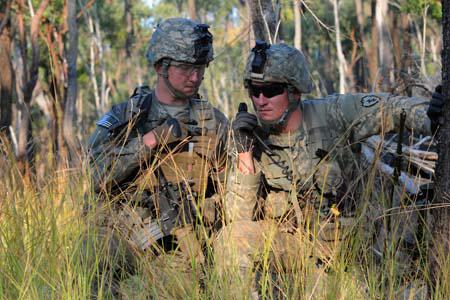Smarter AI for Electronic Warfare
U.S. Defense Department researchers are testing cognitive electronic warfare technologies that within the next decade could autonomously counter adversary systems without preprogramming. The capability may allow the military to eclipse its adversaries in the electronic warfare domain.
Three closely related Defense Advanced Research Projects Agency (DARPA) programs apply artificial intelligence to the electromagnetic spectrum and will likely result in electronic warfare (EW) systems with unprecedented autonomy. The first two—Adaptive Radar Countermeasures (ARC) and Behavioral Learning for Adaptive Electronic Warfare (BLADE) are considered sister programs. Both apply artificial intelligence, or AI, to EW systems.
“With cognitive electronic warfare, we’re imbuing these EW systems to observe a threat system presented by an adversary. They are able to characterize that adversary system on the fly. And they’re able to devise a countermeasure to that adversary system and do all of this in real time,” explains Paul Tilghman, a program manager within DARPA’s Microsystems Technology Office.
ARC, for example, aims to enable airborne EW systems to automatically generate effective countermeasures against new, unknown and adaptive radars in real time. ARC technology is designed to isolate unknown radar signals in the presence of other hostile, friendly and neutral signals; deduce the threat posed by that radar; synthesize and transmit countermeasure signals; and assess the effectiveness of countermeasures based on over-the-air, observable threat behaviors.
ARC technologies use an open architecture to allow for insertion, modification and removal of software modules with minimal effect on other elements of the system. ARC algorithms and signal-processing software will be suitable both for new EW systems and for retrofitting into existing systems without extensively reworking front-end radio frequency hardware, according to a DARPA webpage.
“ARC, as its name implies, is a cognitive EW program specifically targeting radar systems. It’s jamming carried out against radars,” Tilghman says.
The BLADE program is developing machine learning algorithms and techniques to rapidly detect and characterize new radio threats, dynamically synthesize new countermeasures, and similar to ARC, provide accurate battle damage assessment based on over-the-air, observable changes in the threat. The technology is designed to counter new and dynamic wireless communication threats in tactical environments. It also could enable a shift from a manual-intensive, lab-based countermeasure development approach to an adaptive, in-the-field systems approach.
In other words, BLADE targets wireless communications systems rather than radar. “Our objective is to stem or stop or otherwise deny the flow of information,” Tilghman states.
Because EW is a sensitive topic for the military, the program manager cannot offer specifics about program schedules or testing techniques, but he does predict availability in five to 10 years. “We are conducting outside-of-laboratory testing, and at the conclusion of this stage, it will be ready for adoption,” Tilghman reports. “The technologist in me wants to say it is already useful, but from an operational fielding perspective, we’re on that cusp where we are trying to conclude our final set of tests … and hand it off to our service partners in the military and have them begin integrating it into their systems.”
The advanced technology is important in part because military officials have been warning that the Defense Department has fallen behind potential adversaries, such as Russia and China, in the EW domain. During engagements in Iraq and Afghanistan, the United States had the technological edge and little need to worry about attacks on the electromagnetic spectrum. In future wars, the spectrum will likely be degraded, disrupted and denied.
The program manager suggests, however, that EW systems are by nature always behind adversaries simply because enemy systems have to be developed before any countermeasures can be. Cognitive technology, though, may allow the United States to get ahead for the first time.
“This takes us from riding in the back seat, where we’re waiting for a technology and then trying to counter it, to being able to stay ahead of it. We can expect the unexpected and successfully devise countermeasures in real time,” he says.
Still, cognitive technologies may have to fight for a role on the battlefield. Tilghman allows that any hurdles at this point may be more cultural than technological. “Some of the biggest challenges are really about adapting a field that was never meant to have AI as a focal point and really demonstrating to the community at large that not only does AI have a place in the spectrum and a place in electronic warfare, but that it deserves that place,” he says.
Tilghman recalls that when DARPA began exploring cognitive spectrum technologies, the response from many was that the artificial intelligence for EW was either impossible or unnecessary. “We have shown you do need AI to solve this problem because you’re trying to counter something that you can’t expect or can’t preprogram for, so you need to be able to observe and learn from your observations,” he elaborates. “We’ve showcased to the community that AI is really the answer to the question of how to combat adversaries in the radio frequency spectrum when the pace of technological innovation is so rapid.”
The military often is cautious about AI on the battlefield, especially if a machine’s decision would result in dire consequences. But Tilghman maintains that EW is the perfect mission role for cognitive technologies. “The EW world is actually an excellent place to hone AI capability because we’re not asking AI to control a lethal system,” he points out. “The ramifications of a bad decision by one of our intelligent EW systems are really quite low because they can be corrected almost immediately, and the alternate risks are very high.”
While the military usually insists on having a person in the loop to step in if AI makes a mistake, Tilghman argues that cognitive EW systems can be fully autonomous. “Within the right constrained profile, yes, you can have autonomy in our EW systems,” he says.
Tilghman describes the traditional approach to EW as following a strict, preplanned playbook. First, the military surveys adversary radar and communications systems it hopes to counter, and then it preprograms its EW technologies to seek out, identify and block those adversary systems. That made plenty of sense, he says, when communications and radar systems were defined by analog hardware. But many militaries are now developing systems with a digital core. “That means this concept of having a rigid playbook to follow doesn’t really work because what you end up actually seeing on the battlefield may not be the plays that you preplanned,” he says. “Our EW systems can adapt to the unexpected, so we’re able to work outside of the playbook.”
Tilghman oversees a third program related to the electromagnetic spectrum. The Spectrum Collaboration Challenge is not focused specifically on electronic warfare and therefore is not a sister program to ARC and BLADE. It may, however, be considered a first cousin. The program seeks to create a new kind of radio system that is fully autonomous but also can collaborate with other radio systems to dramatically improve spectrum management.
“You can think of the Spectrum Collaboration Challenge as venturing out in a different direction, which is rather than having one smart system, having hundreds of smart spectrum systems,” Tilghman says.
The spectrum is becoming increasingly crowded and stressed as new wireless devices are added—from military systems to cellphones and smart household appliances. Managing the increasing demand is a serious problem for the nation and for the military specifically.
Today’s approach, which is nearly a century old, isolates systems by dividing the spectrum into rigid, exclusively licensed bands allocated over large, geographically defined regions. The approach rations access to the spectrum in exchange for the guarantee of interference-free communication.
However, it is human-driven and not adaptive to the dynamics of supply and demand. At any given time, many allocated bands go unused while others are overwhelmed, according to DARPA’s website.
The Spectrum Collaboration Challenge aims to ensure that the exponentially growing number of military and civilian wireless devices will have full access to the increasingly crowded electromagnetic spectrum. “In the Spectrum Collaboration Challenge, the focus is on communications, but the fundamental technology … has benefits writ large, not just to spectrum operations like electronic warfare but also to other fields, like vehicular to vehicular collaboration,” Tilghman elaborates.
He adds that this is the perfect time to develop autonomous EW systems because the military can take advantage of the commercial sector’s rapid AI advances, and he predicts that the DARPA programs will be only the beginning. “This idea that we need our spectrum systems to be adaptive—and not just adaptive but autonomous—is a philosophy that’s not going to abate. I think we can only expect to see more and more autonomous spectrum systems in the future,” Tilghman says.







Comment
good article
good article
Comments